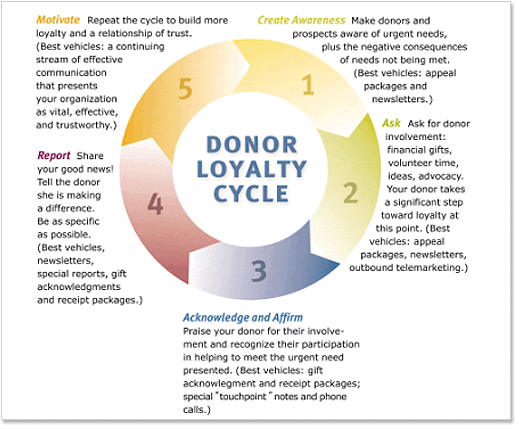|
Building Donor Loyalty: The Key to Successful Fundraising Programs by Timothy Burgess, co-founder of Domain Group, an international direct marketing and communications agency exclusively serving nonprofits You've heard it before: The Internet will revolutionize fundraising. But it is not the technological innovation that is driving this revolution. What makes the Internet such a revolutionary addition to the fundraising toolbox is its ability to help organizations dramatically increase donor loyalty by efficiently building powerful and sustainable relationships. Donor loyalty is an individual's commitment to an organization, demonstrated through the giving of money, time, ideas and influence. This sustained commitment grows in value each year, producing measurable and actionable results. Without this strong foundation of donor loyalty, fundraising programs will stagnate and fail to reach goals. Donor loyalty increases, and net revenue grows, when we establish a rich environment where the donor's needs come first. We must provide frequent opportunities for donor involvement, deliver consistent, relevant information and regularly report how their engagement with our cause is making a significant difference. The most loyal donors are those giving their money and time, sharing their ideas and extending their influence on an organization's behalf. That is why integration across multiple communication channels -- particularly the growing online channel -- is so important. After all, the Internet affords the quickest, simplest and most efficient means to engage with donors regularly and build a relationship. It also allows an organization to collect information about interests, giving history and other profile data that helps the organization to communicate with more relevant and effective messages. Domain Group developed the "Donor Loyalty Cycle" to represent five important steps in building donor loyalty. Each of the five steps must be repeated continually with every donor to build powerful and sustainable relationships.
Organizations interested in strengthening their fundraising programs should ask themselves whether they are successfully completing the Donor Loyalty Cycle. Some questions to consider: Are you coordinating direct mail efforts, online communications and personal contact programs to reach the greatest potential? Are you collecting information about your donors in one donor profile so that you can segment donors and target them regularly with messages relevant to them? Is your message being consistently integrated across all of your programs? Are you properly affirming your donors and reporting how you are using their gifts to make a difference? The power of donor loyalty can help you achieve unprecedented fundraising goals. Here are a few techniques you can implement today:
Timothy Burgess is co-founder of the Domain Group, an international direct marketing and communications agency exclusively serving nonprofit organizations in North America and Europe. He has 26 years of fundraising and marketing experience. He can be reached by e-mail at tim.burgess@thedomaingroup.com or by phone at 206-834-1480.
|
|



